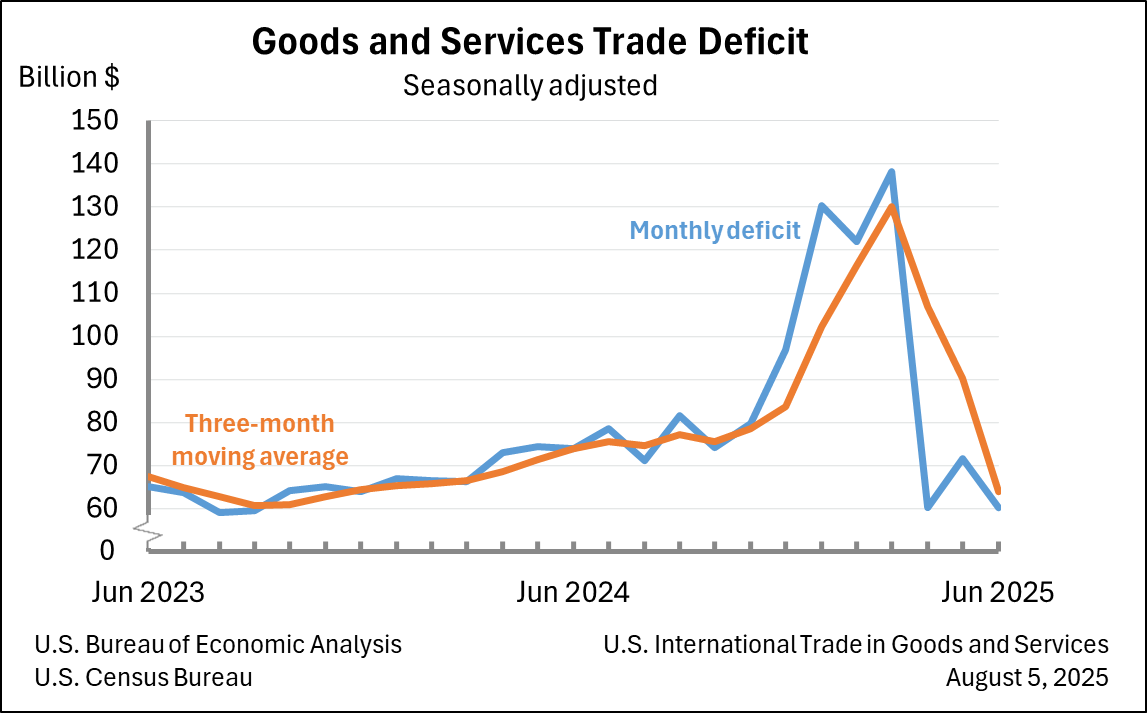Bureau of Economic Analysis
U.S. International Trade in Goods and Services, June 2025
The U.S. goods and services trade deficit decreased in June 2025 according to the U.S. Bureau of Economic Analysis and the U.S. Census Bureau. The deficit decreased from $71.7 billion in May (revised) to $60.2 billion in June, as exports decreased less than imports. The goods deficit decreased $11.4 billion in June to $85.9 billion. The services surplus increased $0.1 billion in June to $25.7 billion.
Principal Federal Economic Indicators
Noteworthy
- 2025 News Release Schedule
- Innovation at BEA
- 2025 Annual Updates
- Distribution of Personal Income Nowcast
- New! Services Trade Data for More Countries
- Data Tool: Trade in Value Added
- Updated: RIMS II Regional Multipliers
- Arts and Culture
- Space Economy
- FDI Now in State BEARFACTS
- Quick Guide: Price Indexes
The Latest
Personal Income and Outlays: February 2020
Personal income increased 0.6 percent in February, the same increase as in January. Wages and salaries, the largest component of personal income, increased 0.5 percent in February, also the same increase as in January.
GDP Increases in Fourth Quarter
Real gross domestic product increased 2.1 percent in the fourth quarter of 2019, according to the “third” estimate released by the Bureau of Economic Analysis. The growth rate is the same as in the “second” estimate released in February. In the third quarter, real GDP also increased 2.1 percent.
Gross Domestic Product, Fourth Quarter and Year 2019 (Third Estimate); Corporate Profits, Fourth Quarter and Year 2019
Real gross domestic product (GDP) increased 2.1 percent in the fourth quarter of 2019, according to the “third” estimate released by the Bureau of Economic Analysis. The growth rate is the same as in the “second” estimate released in February. In the third quarter, real GDP also increased 2.1 percent.
State Personal Income, 2019
State personal income increased 4.4 percent in 2019, after increasing 5.6 percent in 2018. In 2019, increases in earnings, property income (dividends, interest, and rent), and transfer receipts contributed to personal income growth in all states and the District of Columbia. The percent change in personal income across all states ranged from 6.1 percent in Colorado to 2.8 percent in West Virginia.
State Annual Personal Income, 2019 (Preliminary) and State Quarterly Personal Income, 4th Quarter 2019
State personal income increased 4.4 percent in 2019, after increasing 5.6 percent in 2018. In 2019, increases in earnings, property income (dividends, interest, and rent), and transfer receipts contributed to personal income growth in all states and the District of Columbia. The percent change in personal income across all states ranged from 6.1 percent in Colorado to 2.8 percent in West Virginia.
U.S. Current Account Deficit Widened in 2019
The U.S. current account deficit, which reflects the combined balances on trade in goods and services and income flows between U.S. residents and residents of other countries, widened by $7.4 billion, or 1.5 percent, to $498.4 billion in 2019. The widening mainly reflected an expanded deficit on secondary income and a reduced surplus on services that were partly offset by a reduced deficit on goods. The 2019 deficit was 2.3 percent of current…
U.S. Current Account Deficit Narrows in Fourth Quarter 2019
The U.S. current account deficit, which reflects the combined balances on trade in goods and services and income flows between U.S. residents and residents of other countries, narrowed by $15.6 billion, or 12.4 percent, to $109.8 billion in the fourth quarter of 2019. The narrowing mainly reflected a reduced deficit on goods that was partly offset by an expanded deficit on secondary income. The fourth quarter deficit was 2.0 percent of…
U.S. International Transactions, Fourth Quarter and Year 2019
The U.S. current account deficit narrowed by $15.6 billion, or 12.4 percent, to $109.8 billion in the fourth quarter of 2019, according to statistics from the U.S. Bureau of Economic Analysis. The revised third quarter deficit was $125.4 billion. The fourth quarter deficit was 2.0 percent of current dollar gross domestic product, down from 2.3 percent in the third quarter.
Arts and Culture Economy Grows 3.6 Percent in 2017
Arts and cultural economic activity, adjusted for inflation, increased 3.6 percent in 2017, according to the U.S. Bureau of Economic Analysis. That compares with a 5.3 percent increase in 2016. Arts and cultural economic activity accounted for 4.5 percent of gross domestic product (GDP), or $877.8 billion, in 2017.
Arts and Cultural Production Satellite Account, U.S. and States 2017
The Arts and Cultural Production Satellite Account released today by the U.S. Department of Commerce's Bureau of Economic Analysis (BEA) shows that arts and cultural economic activity, adjusted for inflation, increased 3.6 percent in 2017. That compares with a 5.3 percent increase in 2016. Arts and cultural economic activity accounted for 4.5 percent of gross domestic product (GDP), or $877.8 billion, in 2017.




